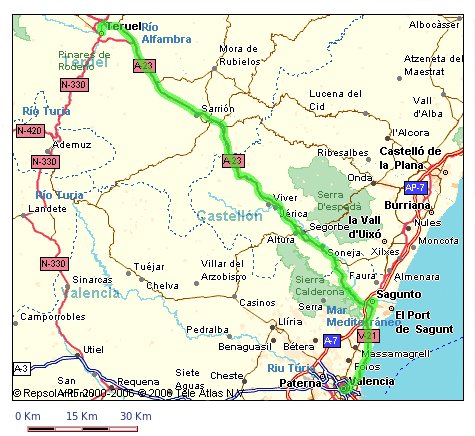Last December, I went to the Delta de l'Ebre with a good number
of friends to spend one of December's three-day weekends. Les Terres
de l'Ebre are the southest region of Catalunya, right next to the border
with the Valencian Country. The Ebre river forms a big delta as it meets
the Mediterranean, and the great amount of wildlife, specially avian, in the
Natural Park makes it a fantastic place to visit.
We would sleep, more or less, in Cinta's appartment in L'Ampolla. The first
night we managed to fit 17 persons for dinner, and about 14 stayed to sleep
in any possible corner of the flat.
As soon as the Valencian group arrived, we tried to meet the people
coming from the North, but apparently they got lost and we stayed on a
sightseeing spot admiring how easily the weather changes here. In an hour or
so, we went from a sunny day to a quick but heavy shower and back to sunny.
When we finally found each other, we decided it was a bit too late to do
anything too special, given the short days in December, so we walked South
along the beach, on our way to the Salines, the salt processing
facility, in the
Punta de la Banya.

Agua para todos...
During the walk, we witnessed what the people from the Delta have been
warning about for decades: the Delta is disappearing. The progressive overuse
of the river's flow, excessive irrigation, damm construction and degradation
is killing this unique place. The waters are slowly claiming what once was
theirs. An electricity line, at the beginning of our trip being at the end
of the beach starts approaching the sea, or viceversa, as you move southward,
to end up many metres inside the water. The old people in the Delta still
remember the 200m tall lighthouse in the Illa de Buda, which the sea
managed to devour.
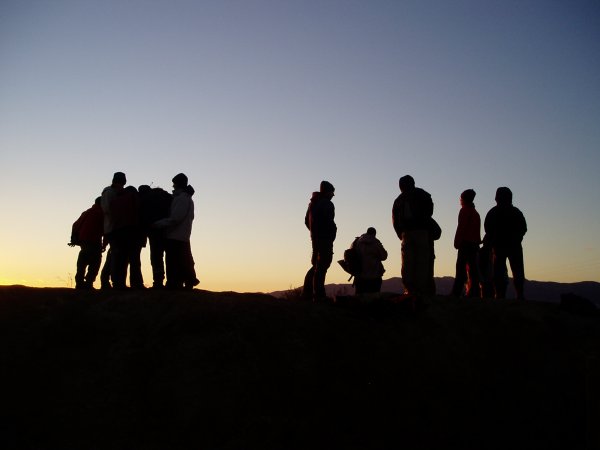
Sunset at the salines del Delta
When we reached the Punta we could watch a beautiful sunset
over the mountains of Els Ports, and when it got dark and cold we
headed to Tortosa, the area's capital, which I had recently visited for the
first time for one of Softcatalà's
meetings. There, we had dinner at a bar and met Jordi and Anna for a while,
before going back to Ampolla, going to bed relatively early due to everyone
being very tired.
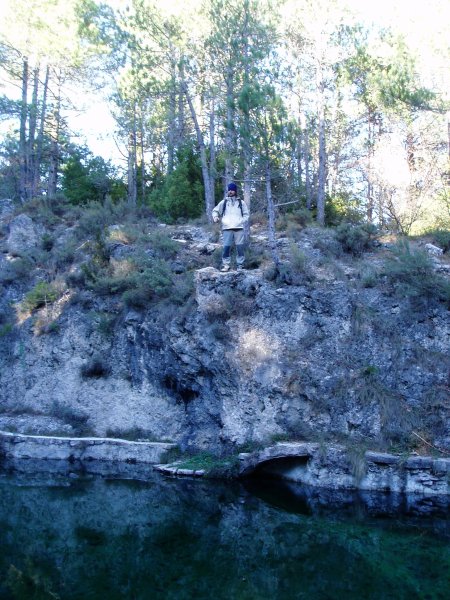
On Saturday, we decided to have a look at the Delta... from above. So we
drove to the top of the Cim del Caro, where we could admire a great
view over the flat farmlands of the Delta, and then found a nice trail which
took us to a nice forest, where we had lunch. After a visit to Alfara de
Carles, we went back to the house, had a great dinner and played fun games at
the table.
Unfortunately, Sunday morning was dedicated to cleaning up the mess in the
appartment and packing, as part of the group, the Jordis from Alcoi and the
twins, had to leave early. The remaining four Valencians decided to go to
Deltebre to have a local paella. It was quite good, although the bar
tender laughed at our request to eat directly from the paella, rejecting
dishes. Small cultural clash. ;)
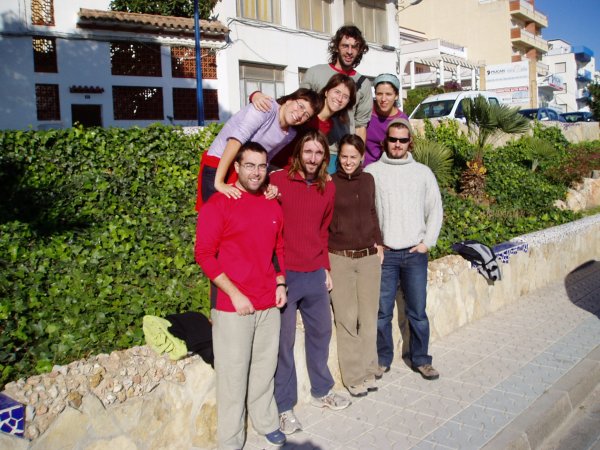
I remember downloading and viewing the pictures of the trip a few days
after getting back in València, and then losing track of them. Last week,
while testing an EPIA board with some random hard drive, I suddenly realised
there was a big chance the pictures would be on that drive, and after some
search, I found them; I had been close to mkfs the disk a few minutes
before. I hadn't stopped blaming myself for misplacing these pictures, as they
remind me of this wonderful weekend. Luckily, they are back!
Going back to the state of the Delta, experts say it will be mostly gone
in 200 years. All of the Terres de l'Ebre have fought against the previous
government's "PHN" plan to divert part of the river's flow to the North and
South, to supply Barcelona, and specially the South of València, where the
developing of the coastal areas is out of control. I fear that whenever PP
regains power in Madrid, they will retake this idea. There is a lot of money
involved in building a 700 km long scar in our land. The Delta de
l'Ebre is a fantastic place which doesn't deserve a terrible fate like
this, only for the benefit of the usual suspects. As the good people of this
land would say...

Lo riu és vida. No al transvasament!
Last month, Belén and I managed to
secure our trip to Tunisia
on the very last moment. So, planning trips on the very last moment isn't
nothing new around this place, but we made a big effort to take things to the
limit.
I can't remember why exactly, but on January 31 we were *so* close to
fucking everything up before it started, when we packed our stuff just a pair
of hours before having to leave to the train station. My luggage was prepared
in a rush, so while I think I took everything I thought I'd need, I didn't
really select my clothes too much. The idea was to have our suitcases mostly
empty to bring back stuff from the markets: smoking cachimbas, lamps,
leather stuff, etc. At that time I didn't know that would end up being a great
strategy.
Anyway, like 9 minutes before the train's departure we were stuck in Nuevo
Centro without a taxi and at that point I really had lost hope about being on
time. For some reason, there were no taxis in the area, when it's normally
a place where there's tons of them. Suddenly one appeared, we rushed in and I
asked the taxi driver to please fly to the station. Happily, we got
an incredible green wave around the avenues, he drove us at like 80 Km/h and
we even had to wait for a few minutes at the station.
In Barcelona, we prepared our small New Year's Eve dinner with my cousin
Laia and Marc, and while the plan was to go to sleep pretty early to be in
good shape to go to the airport next morning, the bottles of wine and cava
emptied quite fast, and around 4:30 we were quite drunk when we decided it was
enough. When some annoying sound woke us up next morning, it was really late,
so we again rushed out to the empty streets of Barcelona, sneaked into a
regional train, without knowing it was the only way to get in time in El Prat
airport, and after some initial confusion trying to find the travel's agency
desk in the wrong terminal, we managed to check into our flight, being the
very last to do so. With all the rush, I couldn't get some clothes from my
suitcase transfered into my hand luggage, which I really wanted to do after
my nice
lost luggage experience
during Debconf 5 in Helsinki.
Anyway, chances are small that your luggage gets lost, right?
But of course, Murphy is always vigilant, and this was a great opportunity
to fuck me up. After a short but horrible (due to our really bad hangover) to
Tunis/Carthage airport, we were in the long security/passport check. When
Belén picked up her bag and mine didn't appear, I tried to tell myself “hey,
it'll appear, no worries!”. After 15 minutes, the stupid suitcase was nowhere
to be found. Apparently, another two pieces of luggage had the same luck,
which made us contact a group of four Uruguayans who were missing one of
them.
Nothing too terrible; it'll surely come on tomorrow's flight. After
reclaiming our lost luggage, we went out to the parking where a bus was
waiting for us, and on the way there, the six of us nearly fell into the
first Tunisian scam, involving a dude selling jasmine flowers at 2€ each.
The bus took us down to Jasmine Hammamet, the most touristic place in Tunisia.
Valencians might have an easy imagining the atrocity of the area by picturing
what twice Marina d'Or plus Benidorm including Terra Mítica
would look like. Kilometres and kilometres of a disgusting “Who can build the
most horrible giant hotel right next to the beach” contest.
So it was pretty clear we had to spend as little time as possible in the
area. We soon learned about how transport works in Tunisia. The cheapest is
to use the public busses and the luagge collective taxis, we soon
found out. Our first morning there, our guide Rejeb, working for Iberojet and
Solplan touroperators, gave a talk where he advised us against travelling
alone, specially around the South, while he offered organised trips around
the country for every day of the week. Although we expected this “danger!”
speech, we decided to book the two day trip to the South and Great South of
the country, basically because it was the best way to see many places in a
short time, even if it meant having limited time in each destination.
We wandered around Jasmine Hammamet and discovered
Carthage Land, sort of a Disneyland
set in the age of Anibal and Carthage's empire, which was inside a newly
built medina complex. This was a really bad place to practice the art of
haggling, as the place was so desert, merchants really tried hard to get
you buy something. Again, we were close to fucking up after our first
negotiation, but we finally decided we weren't so interested. Lucky, we later
found out the price was outrageous.
Sadly, we spent way too much time in that tourist trap, and we found it was
too late to go to the real Hammamet town to see a real medina and real stuff,
so we had a long walk around the immense beach until sunset. On Wednesday, we
did organise a bit with the Uruguayans and some others we had met: María
and Santi “Kuchi Kuchy”, Cristina and Pedro and an Argentinian family, and
managed to hire a van driver to drive us all over the North. For quite a good
price, we were taken to a few ruin sites in Carthago, now mostly a residential
area, and it was really impressive. While the condition of many of the
remainings is not optimal, it was exciting to see things which had been built
by Phoenicians and Romans 2,000 years ago. I really enjoyed the remainings
of the Antonine thermal baths of the city. It had been a huge building right
next to the sea; one of the standing columns helps figuring out
how big it had been. Right next to this site, the Presidential Palace
dominated the whole gulf. Military places are treated zealously in Tunisia,
and it is against the law to take pictures of any bit of it, not even a
barbwire of the fence. The Palace had a great Tunisian flag waving over it,
and many signs advised you against taking pictures in that direction. I
couldn't resist.
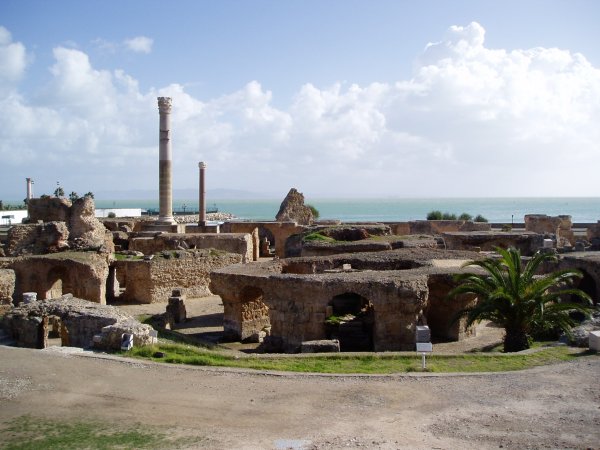
The ruins of the Roman Antonine Baths
After Carthage, we went to Sidi Bou Said, a small touristic town, which had
the peculiarity and beauty of having all windows and doors painted in a
beautiful light blue colour. Our last stop for the day was in Tunis, where we
visited the most amazing medina of the whole week. Unlike the new medina in
Jasmine Hammamet, this one was literally packed with people going up and down
the maze of very narrow streets. Every few metres you'd come across a new,
attractive smell coming from the few salons de thé or spice, leather
or perfume shops. Here we finally started developing our haggling skills, and
managed to get a few items for reasonable amounts.
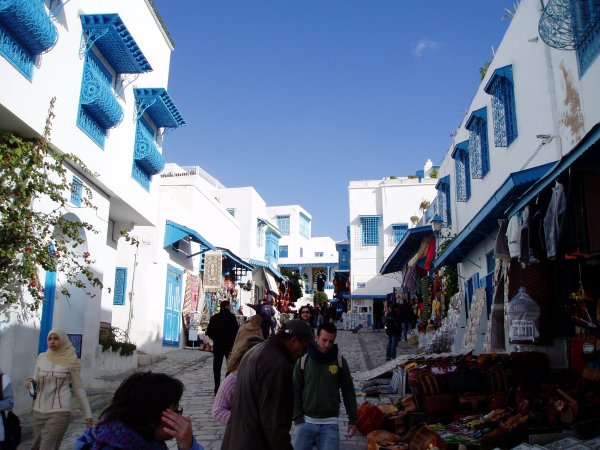
Streets of Sidi Bou Said
Back at our hotel, everyone tried to get a quick dinner and go early to
bed, as next morning we were taking a bus for our trip around the South. There
was time to call yet another time to the Airport, to find out that one of the
luggage pieces had been found. While there was no news about my suitcase, we
shared a taxi to the airport to pick the found suitcase, and see if mine was
actually there by any chance. Unluckily, it wasn't, so I wouldn't have any
clothes for the desert visit. Some people in the group were kind enough to
lend me some t-shirts and pants. For my underwear, I actually resorted to using
some of Belén's (no kidding, it was way too sexy :P), while mine dried up
after some manual washing.
The alarm clock went off at 5:15 or so, and soon after we were ready in the
hall with our small bags. When the bus was ready to pick us up, the guide
said we weren't allowed in, as we weren't on the list. WTF? We were nearly the
first ones to book and pay for it! So he finally let us in, for a short while,
until he realised there was no space for everyone, so he demanded that we
got off. Of course, we didn't, and a long and very disgusting argument started
between the guide, us and a few people who had seen us pay for our trip, and
were trying to support us. To make a long story short, we ended up stepping
down when I noticed the bus driver calling the police, and after Rejeb, our
guide, told us the other bus would be waiting for us at the travel agency if
we quickly took a taxi there. We of course knew that was a fantasy to get the
bus moving, but dealing with the police at 6:30AM wasn't on my list of
activities for the day, so we finally gave up to let the rest of the people
get in time to their visits, as they were very tightly scheduled to make
everything fit in two days.
Nobody was waiting for us at the travel agency, but we were promised our
money back, which did happen in the evening; our plans for Thursday and Friday
were a bit broken though, and the rest of the morning was spent looking for
alternatives. When we had managed to book a new trip in a different agency for
Saturday, we took the bus to Nabeul, the capital of the province, well known
for their medina specialised in pottery.
In Nabeul, we lived a tourist trap which I found to be quite original. Not
having walked 3 metres into the city walls, some young dude stops us and tells
us that he knows us, as he works in the restaurant of “our hotel”. I totally
didn't remember his face at all, but why not? So he quickly tells us Nabeul
has good carpet workshops, and her sister is working in one which is regulated
by the Government, and you can only visit two days a week. Coincidentally,
Thursday is one of them! So he literally grabs us by the arm and takes us to
one of the streets perpendicular to the main market street, and we enter a
carpet shop. To the right, his sister probably being like 45 years
older, is knitting a nice carpet on the loom. And a few seconds after, we're
taken upstairs, where a “Teletienda” show starts before us. Without being
asked if we want to buy a carpet, some other dude starts to unroll carpets
and more carpets before us, talking in some very basic Spanish. While we're
offered jasmine tea, which is really nice, Ali “the brother” quickly excuses
himself and vanishes, leaving us with the salesman, which continues unrolling
more and more before us, now helped by someone else. When 10 minutes later
we convince them that we won't buy any carpet, he asks a donative for his
young employee, who has unrolled and will now roll back a zillion carpets.
Back in the hotel, we have dinner with a pair of Catalans from our flight,
and when we tell us about the carpet place, they tell us they went over the
same story like one hour before us!
On Friday, we got some advice on other places to visit, and decided to go
up to Cape Bon and visit Kerkuan, the only important remainings of a
Punic city which, when conquered by the Romans, was destroyed to the
grounds, but not rebuilt on top (they were busy with Carthage). Romans did an
excellent job when destroying cities, and the result is a site which still
lets you see perfectly how a small town (around 1,500) looked like 2,000 years
ago.
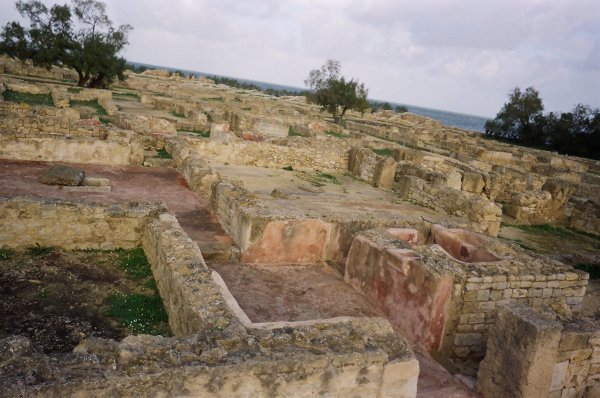
Ruins of a Kerkuan neighbourhood, with their red bathrooms nearly intact
To reach Kerkuan we had taken the bus up to Nabeul and then our
first luagge to Kelibia, where we took a taxi (after no less than
half an hour arguing in French with the taxi driver to settle on a rate for
a ride to Kerkuan and then to the tip of the Cape in El Haouaria. Luagges
are undoubtedly the best way to travel medium distances for very little money,
while getting mixed with locals. During our ride up North, we chatted with
a nursing student from Kelibia who was going back to her town for the weekend.
She was really open, like most of the people we found in Tunisia, and we ended
up exchanging our post addresses; we still need to send her a postcard from
València soonish. This area wasn't so touristic, so the roads, while totally
acceptable, weren't as good as the highway from Tunis to Sfax we were
used to.
We had seen some bits of the local “driving skills”, but the luagge driver
performed some of the most extreme overtakings I've ever seen. These happened
every three of four minutes, so after a while I was actually amused about
what was going on. We would overtake two lorries on one go when there was
absolutely no visibility; if things went too far, people would just slow down
to let the overtaker get back into his lane on time, and those coming ahead
would just use their headlamps to make them know it was just a bit too
close.
The taxi driver, annoyed at us, took us to Kerkuan but didn't wait for us;
he immediately left, leaving us without any transportation in the middle of
nowhere. After a visit at the site, we walked around 2.5 kilometres back to
the main road, where we decided it was too late and risky to continue the
journey up to El Haouaria, so we waited on the road gutter for a taxi. The
first one which stopped was, to our surprise, the same bastard who left us
one hour before, who stopped, laughing at us a little. Luckily some other
taxi came by in the correct direction, and soon forgot about that man.
After a taxi, luagge and bus ride, we were back in Hammamet, and the
desert group had already got back from the two day trip. We were asked over
and over what happened, what did we do, etc. People who hadn't talked to us
before would come over and see; we were really surprised about the warm
welcome we had. After dinner, we improvised a customes party, and many people
managed to dress up in Tunisian/arabic fashions using bed sheets and so on. We
had to wake up at 5AM next morning, but didn't go to bed until 2AM.
Nothing could go wrong this time. We had our tickets, we had confirmed we
would be going on Sunday the night before, so at 6:15, our new guide came in,
and came straight towards me. He said something in German, and after I told
him I spoke absolutely no German, he said “huh, well you know the bus is full
of Germans, and my indications will be in German?”. Pretty incredible, but
again a fuckup by the agency. My ticket said, clearly: Sahara safari. Bus +
4x4. (ALL)
. Turns out “ALL” meant Allemand, not “everything included”,
although we had requested English pretty clearly. This was quite a minor
problem though, after having no clothes for a whole week and having been left
behind two days before.
I think we were really lucky getting that German group, though. We were
only 16 people on the minibus, making the stops a lot faster than the normal
ones, where 55 persons need to get out and in of the bus. We had our own
Routard guide for Tunisia, so we could read about the places we were
about to visit before getting ther. Also, I surprisingly knew much of what
our guide was talking about, just missing the details —he talked about oil
production in Tunisia compared to Spain's, among other topics—. When the
landscape was becoming drier and drier, Belén and I spotted something dark far
away ahead in the completely straight road. As it became bigger, I started
thinking it might be the #1 place to visit for me in Tunisia: El Djem's
impressive Roman amphitheatre.
When we got off the bus, I was totally excited. Before me, the walls of
an incredibly well preserved, huge Roman building; in fact, the best Roman
ruins in the whole continent. El Djem's amphitheatre was the third biggest
of the Roman empire with 35,000 seats, only surpased by Rome's and Capua's.
It remained mostly intact until the 17th century, when some of its stones
were used to build the city and some of the treasures taken to the
Great Mosque of Kairouan, but when it took more damage was during two
consequent wars, when the Turks didn't have many problems to blow part of
the wall away using cannons to end up a siege of the city.
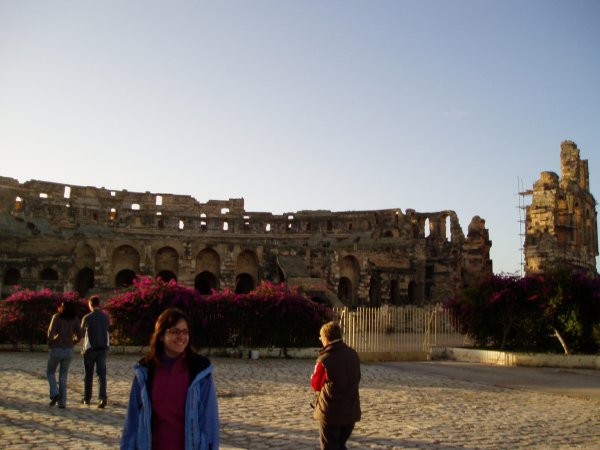
The Roman amphitheatre of El Djem
The underground tunnels are intact, and it's difficult to not have
flashes of Gladiator while
walking under the arena's trapdoors. Sadly, there was little time to spend
there, and we had to continue the journey after just 45 minutes. I would have
spent half of the day there.
From here, the landscape truly started to get drier and more desertic.
The south of Tunisia is a giant olive field, until you reach the Great
South, where it's dry enough that the only thing that grows in the
land are rocks. Hours later we arrived in Matmâta, the very famous
troglodyte village of small holes in the ground. Although I was
curious about being there, watching how organised and massive tourism has
destroyed these Berber's ways of life dissapointed me greatly. Our guide
stopped the bus in one of the pits, which was decorated with white and
light blue. In the first room, an old woman was grinding something in a
small, stone mill. The dwellers of the few pits still used by their
original inhabitants now make a living by letting people into their homes
and getting dinar as a payment for taking photographs. What the woman was
doing was just a bit of theatre, part of the show. After this first room, we
got into the middle of the pit, which had a series of other passages to some
rooms, some of which were simply open so we could get in and have a look.
I felt a little bit like violating someone's privacy, and wondered how much
the house had changed in the last years.
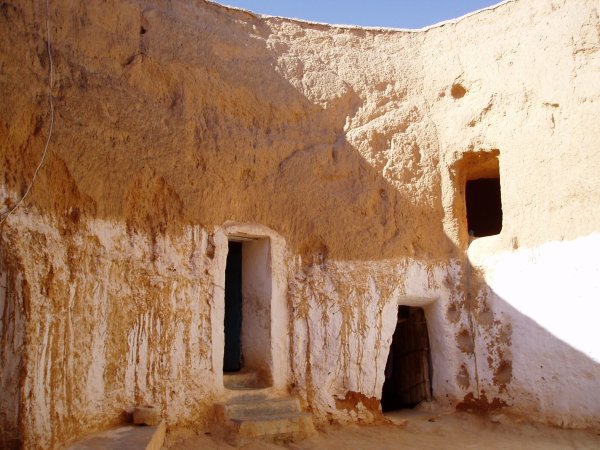
Inside a troglodyte underground house in Matmâta
After our visit, we continued up the mountains of Matmâta, and after
going by a giant "WELCOME TO MATMATA" sign drawn in white in the middle of
a mountain, Hollywood style (!), we stopped for a brief photo-stop
(sic). Indeed, the view was quite impressive, and is universally famous as
one of the filming spots of Tatoonie scenes in
Star Wars: A New Hope.
Speaking of famous places, a few minutes later we stopped at the top of one
of the hills, were we'd have lunch in the Hotel Sidi Driss, a place of
pilgrimage for Star Wars fans, as it was the troglodyte pit which served
as the Skywalker's home. The place is full of references to the film saga,
and one of the open pits is full of set pieces stuck into the walls. We were
served couscous, which wasn't bad, but was cooked and served in the most
genuine fast-food fashion. Everyone there gets couscous to eat, apparently,
and it's the same in many other touristic places in the area.
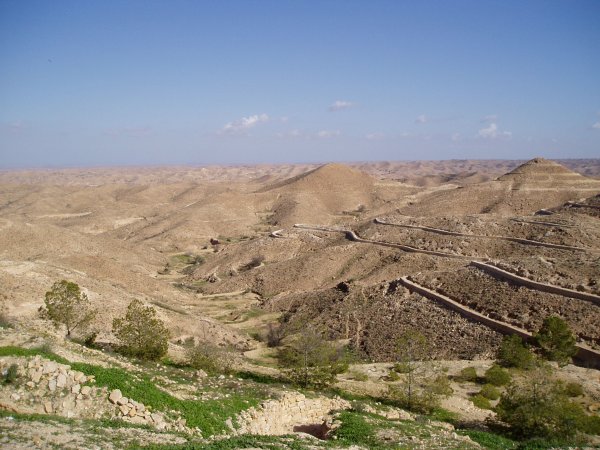
Matmâta's lunar landscape
From here, our journey headed straight West, in the middle of the
rocky desert, until after some time, you could start to see lines of palm tree
branches planted here and there, a sign that rocks would soon disappear, being
replaced by sand and dunes. As when we were approaching El Djem, at some
point a huge, dark spot appeared on the horizon.
Douz, probably named after some 12th French batallion which stayed there,
is a small town in the very limit of the Sahara desert, built right next
to a huge oasis, exclusively dedicated to palm tree plantations, making dates
production a big source of income, along with, of course tourism. The travel
agencies use Douz as the starting point for several-day trips into the
desert, camel rides and stuff like this. Our guide offered us getting a camel
and carriage ride in Tozeus for 20 dinar, but Belén and I declined. He didn't
seem to be too happy about it, and had no problem commenting this in German
and Arab with the driver (Spanisch and Spanien were clear
to me). We learned that the agency (or the guide) makes around 3 Dinar for
everyone who contracts the camel rides, after speaking to one native young
kid who worked in the camel place. While our German trip mates got dressed
in berber fashion, we opted to walk into the desert and play around in the
sand on our own. I discovered a few desert insects which were unlike anything
I've seen anywhere, and their diminute trails were all over the dunes.
Looking West, the view was astonishing, with only thousands of kilometres of
yellow dunes ahead us.
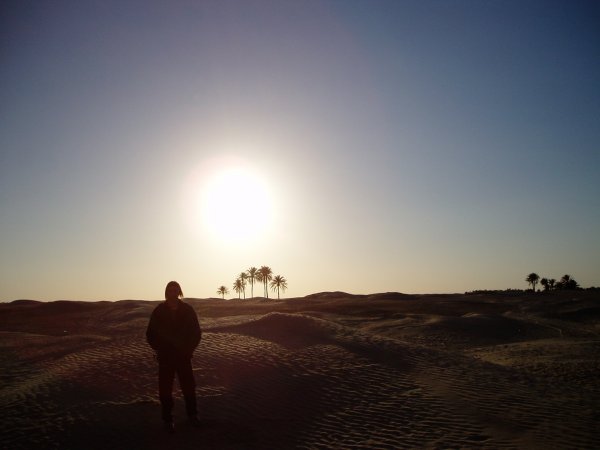
The evening sun over the dunes
After they came back, we were taken to our hotel, which was really
impressive. After leaving our stuff in our room, we headed back to the
desert, which was like 300 metres away, to see the sunset over the “Great
Dune”. There's a street which literally serves as the frontier between the
rocky ground and the sand desert. From there, you could see many lines of
palm tree branches, which are planted by locals in a futile attempt to stop
the inexorable advance of the desert. Women in Douz and other towns in the
desert limit spend their days sweeping the entrances to their homes, as sand
gets in really fast. A small village next to Douz even had to be abandoned and
rebuilt in some other place, with the old one being finally devoured by the
dunes.
When it got dark, we still had some time to kill before dinner, and we
discovered a hammam in our hotel. I got in, and saw there was a bored young
man inside. He informed us about the prices, and after some short deliberation,
we realised we'd spent half of the camel money in some Arab relaxation; while
I got a really cool massage, Belén enjoyed a Turkish bath. I spoke to the
guy for a while, and he said not that many people used that hammam. He actually
handed the list of services since 2002, which easily fitted in one piece of
paper. People don't know what they are missing; he explained that most of the
hotel's clients just showed no interest in the baths. I wonder how
Fins or Norwegians would react, given their sauna culture. The dinner and
breakfast in that hotel was absolutely awesome, and I actually ate too much
to have an easy sleep.
Next morning we had to be ready at 5:30. That's pushing my limits. The bus
started crossing the Chott Jerid when it was still quite dark. The
chotts are dry, salt lakes in the middle of the desert, which during
some seasons do get some water, sometimes from the underground. The Chott
Jerid is the biggest of the three chotts in the area, and the views are
fantastic. It's like a giant, totally flat muddy sea which reflects light
creating dangerous mirages of oasis-like dark patterns. Before the
construction of the recent road that links Douz and Tozeur, crossing the
chott was so risky that many people died in the attempt. We had the unique
opportunity to see the sun rise over the salty horizon.
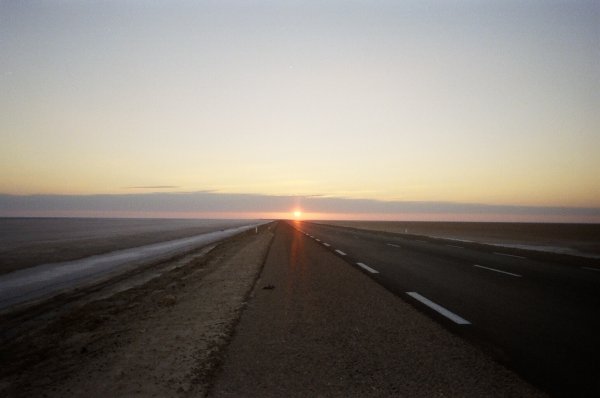
Sunrise at the Chott Jerid
Again, on our way to Tozeur, we were offered a carriage ride for ten dinar,
and again we declined. The guide then asked us if we had no money or what.
So in Tozeur we basically wanted to walk around the oasis fields, and ended
up talking most of the time with some old man who sold drums and desert
roses.
On a 4x4, we went up North to Chebika, a really cool town with a small
oasis of thermal water, which I guess was around 40°C. The short walk to
the wall where the oasis surfaced was packed with children who insistently
begged for money or offered necklaces and other items. It was difficult to
make them understand you didn't want anything. We then went up the mountain
behind Chebika through a road which had its own piece of history. It seems
that during WWII, Rommel suffered an Allied siege in Chebika, with a range
of mountains behind their backs. The Allies gave him one month to surrender,
and he took his time to answer. During that time, he ordered his engineers to
design and build a road which would let them escape Chebika through the
steep mountains, and they managed. When the ultimatum expired, the Allies
apparently found out Chebika had been abandoned by the Germans, including
tanks and most of their equipment. So, on the way up, a few kilometres away
from the Algerian border, there was another typical visit to the biggest
oasis waterfall in Tunisia, which was several metres high.
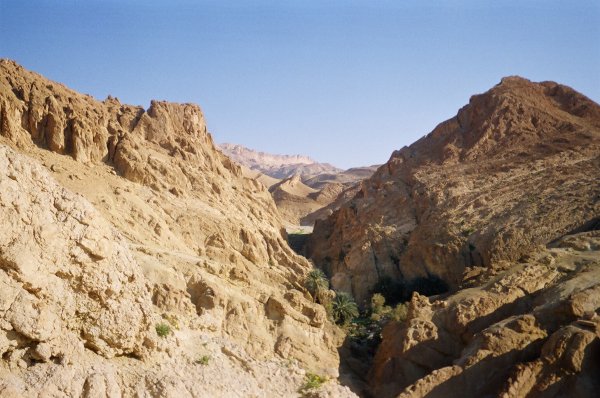
The oasis at Chebika
Our Sahara trip would soon end, and after lunch we headed Northeast on
our way to Hammamet. On our way back, we stopped in Kairouan, one of the
key Islam pilgrimace spots, with the Great Mosque as the biggest attraction.
Unluckily, as we arrived after lunch, we didn't had a chance to see it.
Apparently it is really impressive. We haggled a bit for a pair of
babouches and a small leather couch in the medina.
We came back to our hotel around 7, and found most of the people around
the hall. After the obligatory update on how it went, we went to bed
as we were exhausted, and of course we had to get up really early to
head to the airport. The airport was at that early time of the morning a
total chaos, and while people stood in the checkin lines, I tried to find
out what was going on with my still lost luggage.
I went back to the lost luggage window, which would be closed for 5 more
minutes. When they finally opened, they told me once again they had no clue
about what was going on with my luggage. I finally understood they had
no clue: my tracking number wasn't in their database. I asked
them if I could have a look at the unreclaimed luggage storage room. They
kindly opened a small door for me, and invited me to go inside and have a look.
The view was gross: hundreds of lost bags all over the place. As I was in a
bit of a hurry (I actually had to get back to Barcelona), I asked him where
to find the bags of one week ago, and he nearly bursted into laugher. Okay,
I had to look all over the place, scanning every piece of luggage in an
attempt to spot mine. There were bags of absolutely every type in there.
In one of the corridors, I sensed a disgusting smell, and figured out some
poor guy may have food or something in one of their lost bags, which was
rotting in that horrible room. So wrong: soon after I found myself nearly
stepping on a puddle of shit, as if someone had literally dumped it right
there. Oh my... luckily my search was nearly over and unsuccessful, and I
got back to Barcelona with the hope of finding my bag in El Prat. After looking
in their two storage rooms I realised I'd probably not see the luggage again,
which is a real pain in the ass.
A few hours of train later we were back in València, with a feeling of
having spent 3 or 4 weeks in Tunisia, not just 8 days. Really a great place
to visit, not only for their cultural treasures, both current and ancient, but
for the openness of their people. I hope I'll be back at some point!













